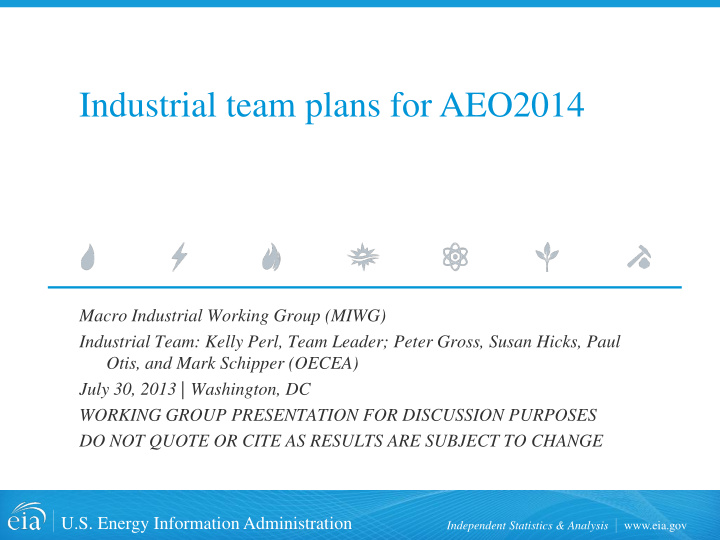



Industrial team plans for AEO2014 Macro Industrial Working Group (MIWG) Industrial Team: Kelly Perl, Team Leader; Peter Gross, Susan Hicks, Paul Otis, and Mark Schipper (OECEA) July 30, 2013 | Washington, DC WORKING GROUP PRESENTATION FOR DISCUSSION PURPOSES DO NOT QUOTE OR CITE AS RESULTS ARE SUBJECT TO CHANGE U.S. Energy Information Administration Independent Statistics & Analysis www.eia.gov
Overview -- AEO2014 • Process flow status & updates • Other model updates • Major data updates • CHP updates WORKING GROUP PRESENTATION FOR DISCUSSION PURPOSES Industrial Team 2 DO NOT QUOTE OR CITE AS RESULTS ARE SUBJECT TO CHANGE Washington DC, July 30, 2013
Process flow models • General: – Replace energy consumption based on engineering judgment with specific technology or equipment choice e.g. anode production for primary aluminum – Also can choose technology diffusion – Technologies are primarily based on CIMS data from DOE’s Pacific Northwest National Laboratory • Completed by AEO2013 – Cement & Lime – Aluminum • Completion for AEO2014 – Glass (defaulted) – Food (not a process flow model; revise on more detailed shipments data) WORKING GROUP PRESENTATION FOR DISCUSSION PURPOSES Industrial Team 3 DO NOT QUOTE OR CITE AS RESULTS ARE SUBJECT TO CHANGE Washington DC, July 30, 2013
Glass characteristics • Glass types used in process flow model – Flat glass – Container glass – Pressed & blown glass – Glass fiber – Note: glass made from purchased glass still uses TPC approach • Process steps: preparation, furnace, form & finish, tempering (flat glass only) • Furnace types include conventional, electric boost, & oxygen fueled WORKING GROUP PRESENTATION FOR DISCUSSION PURPOSES Industrial Team 4 DO NOT QUOTE OR CITE AS RESULTS ARE SUBJECT TO CHANGE Washington DC, July 30, 2013
Other planned model updates • Cement multi-channel burner addition to CIMS (defaulted) adds flexibility for fuel mix of mono-channel burners for later AEOs and contributes to AEO2014 efficiency side cases. • Efficiency case for cement – Multi-channel burners considered state-of-the-art in cement industry • Allow significant amounts of secondary fuels – i.e., achieve high or higher levels of alternative solid fuels (ASF) – e.g., tires, plastics, wood, waste • Fuel mix for individual kilns is unavailable but IDM presumes a 12 percent share of ASF in dry process kilns; wet process is likely higher – More rapid penetration of energy efficient grinding; affects electricity • Efficiency case for aluminum WORKING GROUP PRESENTATION FOR DISCUSSION PURPOSES Industrial Team 5 DO NOT QUOTE OR CITE AS RESULTS ARE SUBJECT TO CHANGE Washington DC, July 30, 2013
Cement burner technology update Fuel share in the cement industry AEO2013 : 6 mono-channel burner technologies percent AEO2014 : Adds a multi-channel burner technology LPG and HGL Wood Chips Cement industry Waste Gas reports 246 trillion Btu Residual Fuel Oil consumed in 2010. Coal Coke Distillate Fuel Oil Waste Oils/Tars Natural Gas Other Net Electricity Petroleum Coke Coal 0% 10% 20% 30% 40% 50% 60% Source: U.S. Energy Information Administration, MECS2010. WORKING GROUP PRESENTATION FOR DISCUSSION PURPOSES Industrial Team Washington DC, July 6 DO NOT QUOTE OR CITE AS RESULTS ARE SUBJECT TO CHANGE 30, 2013
Major data updates • Quadrennial MECS update to 2010 • New nonmanufacturing data approach – Uses Census and USDA data to derive usage data from expenditures – Improves estimation of nonmanufacturing energy use for individual tables instead of relying on SEDS – MECS; • construction use of natural gas had been overestimated • Construction expenditures were for “Natural gas OR manufactured gas” – Will use SEDS – MECS for benchmarked figures in Table 6, main industrial table, of the AEO WORKING GROUP PRESENTATION FOR DISCUSSION PURPOSES Industrial Team Washington DC, July 7 DO NOT QUOTE OR CITE AS RESULTS ARE SUBJECT TO CHANGE 30, 2013
MECS 2010 v. MECS 2006 Energy use in quadrillion btu 7.0 6.0 5.0 2006 4.0 2010 3.0 2.0 1.0 0.0 WORKING GROUP PRESENTATION FOR DISCUSSION PURPOSES Industrial Team Washington DC, July 8 DO NOT QUOTE OR CITE AS RESULTS ARE SUBJECT TO CHANGE 30, 2013
Combined Heat and Power (CHP) • Differentiation for major CHP-using industries: bulk chemicals, paper, food, iron & steel (refining modeled in LFMM) – Allow variation in utilization, risk factor, penetration rate for four major CHP industries allows to run mini side cases – Big 4 industries constitute more that 75% of IDM CHP in all AEO2013 years – All other industries undifferentiated • Regional differentiation • Data updates – Update industrial CHP based on EIA’s historical data – Will update regional CHP scorecards when ACEEE data becomes available WORKING GROUP PRESENTATION FOR DISCUSSION PURPOSES Industrial Team 9 DO NOT QUOTE OR CITE AS RESULTS ARE SUBJECT TO CHANGE Washington DC, July 30, 2013
Thank you for your attention! Macro Team: Kay Smith ( 202) 586-1132 | kay.smith@eia.gov Vipin Arora (202) 586-1048 | vipin.arora@eia.gov Russell Tarver (202) 586-3991 | russell.tarver@eia.gov Elizabeth Sendich (202) 586-7145 | elizabeth.sendich@eia.gov Industrial Team: EIA-OECEAIndustrialTeam@eia.gov Kelly Perl (202) 586-1743 Peter Gross (202) 586-8822 Susan Hicks (202) 586-4388 Paul Otis (202) 586-2306 Mark Schipper (OECEA) (202) 586-1136 WORKING GROUP PRESENTATION FOR DISCUSSION PURPOSES Industrial Team 10 DO NOT QUOTE OR CITE AS RESULTS ARE SUBJECT TO CHANGE Washington DC, July 30, 2013
Recommend
More recommend